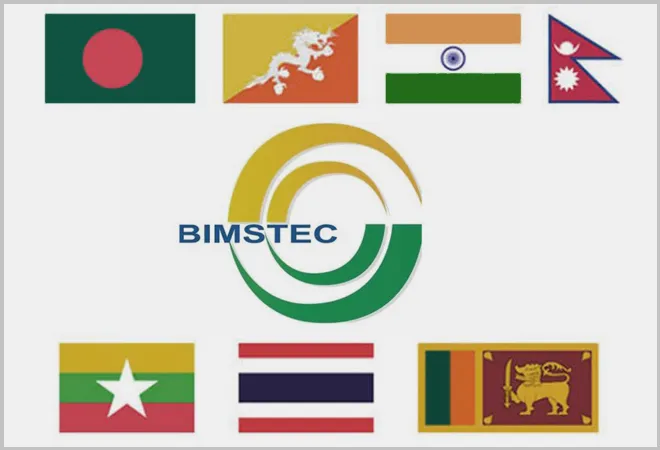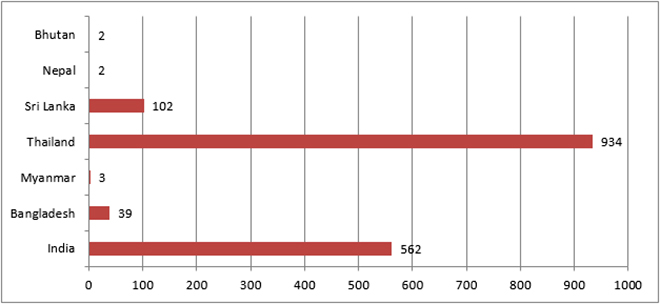-
CENTRES
Progammes & Centres
Location

Conceived in 1997, the Bay of Bengal Initiative for Multi-Sectoral Technical and Economic Cooperation (BIMSTEC) is a grouping of 7 countries in South and South East Asia which includes India, Bangladesh, Sri Lanka, Myanmar, Thailand and the two landlocked countries of Nepal and Bhutan. In the 8th BIMSTEC ministerial meeting in Dhaka, 2005, Thailand proposed that the sector on traditional medicine (for facilitating efficient use of natural resources found in the member countries) should evolve into a comprehensive area of cooperation on 'Public Health', which is one of 14 sectors of cooperation under BIMSTEC at present. Until now there isn't much progress in this domain, but the outbreak of the Coronavirus pandemic brings to the fore how BIMSTEC needs to rise to the occasion in terms of advancing the ‘Public Health’ agenda in its future course of action. More importantly, the dependence of the BIMSTEC countries on the Chinese economy poses potential threats to containing COVID-19 in the near future. The following figure shows the COVID-19 positive cases in the BIMSTEC countries as of 25th March, 2020.
Figure: COVID-19 Positive Cases in the BIMSTEC Countries
 Source: World Health Organization
Source: World Health OrganizationApart from the strategic location of the BIMSTEC countries and abundance of social, physical, natural and human capital in the region, BIMSTEC had received a renewed vigor in recent times mainly on two fronts – the stagnation of SAARC which largely limited the scope for India's economic ambitions with Pakistan's stakes in it, alongside India's fears over the involvement of China in the almost annulled Bangladesh-China-India-Myanmar (BCIM) Economic Corridor. Secondly, India's non-participation in China's 'Belt and Road Initiative' makes it all the more important for India to strengthen its own strategic and economic ties in South Asia.
Despite India's regular attempts at keeping China out of its regional groupings for economic reasons (for example, India opting out of the Regional Comprehensive Economic Partnership last year), China is entrenched in almost all the economies of the world including the BIMSTEC countries. The following table, based on latest available data, depicts China's interconnectedness with the BIMSTEC countries. As China is the originating country for this global health disaster, these significant interlinkages are important to assess in current times when scientists across the world are predicting further outbreaks of COVID-19 in the future.
Table: BIMSTEC Countries' Economic Engagement with China
| BIMSTEC Countries/Groups | China's Total Trade (2017) in Million USD | Number of Persons Abroad (2017) in Chinese Contracted Projects & Labor Services | Chinese FDI Utilized (2017) in Thousand USD |
| India | 84388 | 1444 | 157720 |
| Bangladesh | 16044 | 8197 | 100 |
| Myanmar | 13475 | 4682 | 1700 |
| Thailand | 80138 | 3405 | 110230 |
| Sri Lanka | 4398 | 4308 | 220 |
| Nepal | 985 | 1723 | 10 |
| Bhutan | 6 | No Data | No Data |
| BIMSTEC | 199434 | 23759 | 269980 |
| Asia | 2126525 | 667584 | 109193870 |
| BIMSTEC's Share in Asia | 9.38% | 3.56% | 0.25% |
| World | 4107164 | 979169 | 131035130 |
| BIMSTEC's Share in the World | 4.86% | 2.43% | 0.21% |
Source: Author's own using data from Chinese Statistical Yearbook 2018, National Bureau of Statistics of China.
Against this background the BIMSTEC countries need to pay heed to the following two aspects:
A new direction was added to India's foreign policy when the heads of the BIMSTEC states were invited to PM’s swearing-in ceremony for the second term in 2019 in contrast to the presence of SAARC leaders at the same ceremony during his first term in 2014. However, the PM’s turn towards SAARC in the middle of the Coronavirus emergency and India’s decision to contribute 10 million USD towards a ‘SAARC COVID-19 Emergency Fund’ depicts BIMSTEC's failure as an organization in preparing for such catastrophic situations, and more specifically, its lack of progress in the ‘Public Health’ sector which has a direct bearing on the economy and the well-being of the people in the region.
Africa and Asia are urbanizing faster than the other regions in the world and are projected to become 56% and 64% urban, respectively, by 2050 – many of these rapidly urbanizing cities are in the BIMSTEC countries. Increased globalization, connectivity and economic integration are set to drive the urbanization processes in these growing centres in Asia, which raises the vulnerability of these countries to human-borne diseases like this. Therefore, it is imperative for BIMSTEC to take the lead in this region in becoming economically independent to a certain extent and at the same time build a robust public health system to deal with future medical emergencies like the ongoing COVID-19 disaster.
The views expressed above belong to the author(s). ORF research and analyses now available on Telegram! Click here to access our curated content — blogs, longforms and interviews.

Soumya Bhowmick is a Fellow and Lead, World Economies and Sustainability at the Centre for New Economic Diplomacy (CNED) at Observer Research Foundation (ORF). He ...
Read More +